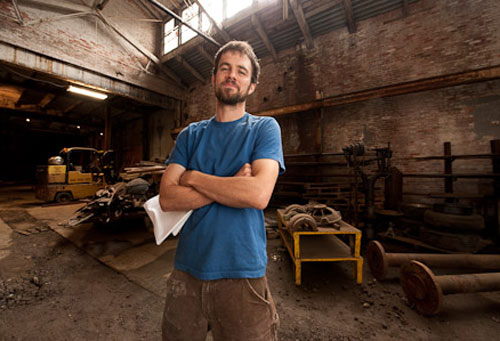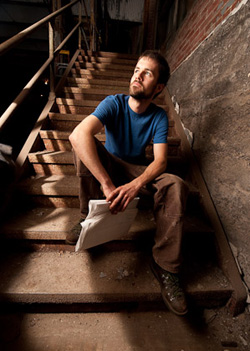 Pat Sells and Casey Tyrrell had bold plans but few illusions when they took over an abandoned factory in downtown York and set about remaking it into a home, a workshop and a magnet for the surrounding community.
Pat Sells and Casey Tyrrell had bold plans but few illusions when they took over an abandoned factory in downtown York and set about remaking it into a home, a workshop and a magnet for the surrounding community.
A local painter, Paul Kicklighter, told them it would probably take a couple of years to clean up the three-story, 26,000-square-foot building, which had been abandoned for years. Sells, 28, replied that the project would take the rest of his life.
Sells and Tyrrell may soon have something to show after nearly two years of toil. But four bats roosting in a first-floor hideaway are a reminder of what remains to be done.
“It’s slower, and I kind of expected it to be slower,” Sells says. “All the approvals, that just takes a lot of time.&qquot;
 The pair, friends since middle school, bought the 87-year-old factory in 2007 as a home for their metalworking business, Salvaging Creativity. Originally from Maryland, they turn found metal objects into office and household items, ranging from signs and door handles to wine racks and coffee tables. They plan to live in a third-floor space and convert the other floors into a sort of community center where other artists can work and show off their creations.
The pair, friends since middle school, bought the 87-year-old factory in 2007 as a home for their metalworking business, Salvaging Creativity. Originally from Maryland, they turn found metal objects into office and household items, ranging from signs and door handles to wine racks and coffee tables. They plan to live in a third-floor space and convert the other floors into a sort of community center where other artists can work and show off their creations.
Toward a creative economy and community
Their vision is a hit among the arts community in York, a town of about 41,000 people. “It’s a huge undertaking, but why not? They’re young. They can do it, ” says Brenda Wintermyer, a painter who owns a gallery in downtown York. “If they’re going to do it, they’re going to do it now at this time of their lives.”
Neighbors and local artists often drop in to lend Sells and Tyrrell a hand. Kicklighter chips in by picking up a broom and cheering them on. “I think they’re building an institution here,” says Kicklighter, who is retired after a career as a jet mechanic.
Eric Menzer served as York’s economic development director from 1994 to 2001. For him, the project epitomizes the city’s shift toward the new, creative economy. And it shows what two ambitious entrepreneurs can do without major government help. So far, the only public-sector aid for Sells and Tyrrell has come from York’s artist homesteader program, which offers modest grants for creative types to live and work in the city.
“Fundamentally, they’re doing it for profit, which is exactly how it’s supposed to work. We don’t have to subsidize everything,” says Menzer, a senior VP at Wagman Construction, a York-based company involved in rehabilitating several old buildings in York. The company’s headquarters boasts signs, door handles and other features fashioned by Sells and Tyrrell. Not that cities have no role to play, Menzer adds. They can ensure building codes are handled flexibly.
 “It’s not about breaking the rules,” he says. “It’s about figuring out how to take advantage of those rules and make them work for the situation that’s at hand. There’s just absolutely no question that’s what cities like York have to do if they want to be able to get and keep people like Pat and Casey.”
“It’s not about breaking the rules,” he says. “It’s about figuring out how to take advantage of those rules and make them work for the situation that’s at hand. There’s just absolutely no question that’s what cities like York have to do if they want to be able to get and keep people like Pat and Casey.”
York County is not viewed as an artistic destination, even by its residents. More than half the nearly 2,500 people responding to a recent countywide survey said they travel to Baltimore, Harrisburg and Lancaster for the arts, according to the Cultural Alliance of York County. But on June 9, the alliance unveiled a plan to bolster the arts scene in the city and county by, among other steps, raising its profile and bringing together all the groups with a stake in it.
From rubble to renaissance
Sells and Tyrrell started making plans for the old factory as soon as they saw it in 2007. They paid $107,000 for the brick building at the corner of West Philadelphia and Hartley streets and have poured in additional thousands since, along with hundreds of hours of sweat equity.
The building is still relatively raw. Windows are broken where they aren’t boarded over, the floors are alternately muddy and dusty and piles of rubble lie about. But signs of progress also are evident. Casey and Tyrrell have installed the beginnings of a bathroom. And in May, workers were putting in a sprinkler system, which city officials said was necessary before anyone could live in the place, Sells says. His future apartment is still bare, save for an old refrigerator he and Tyrrell hauled up the stairs. They were relieved to learn it still worked.
 Once the two move into the building, they will be able to devote more energy to their project, Sells says. He splits his time between York and northern Maryland. Tyrrell, who has a degree in marine engineering, works regular stints for a tugboat company.
Once the two move into the building, they will be able to devote more energy to their project, Sells says. He splits his time between York and northern Maryland. Tyrrell, who has a degree in marine engineering, works regular stints for a tugboat company.
The sprinkler system should be in place by July, but Sells already is scoping out the next improvements: beefing up the electrical service and installing new windows on the side of the building facing West Philadelphia Street. Windows overlooking the first floor are covered.
More sunlight would chase away the bats and reduce demand for electric lights, Sells says. So, he and Tyrrell are applying to a state grant program for small businesses pursuing energy efficiency. But as with everything else they try, the friends are learning the redevelopment process is geared toward over-and-done projects rather than two guys trying to remake an old factory one slow step at a time. They had no real operating history, for instance, on which to base their estimates of future energy savings, Sells says.
“Fortunately, they’re quite intelligent, ” says Kicklighter one spring morning after dropping in to check on the building’s progress. “That’s debatable, ” quips Sells.
Joel Berg is a freelance writer, part-time writing teacher and recovering business reporter living in York. Send feedback here.
To receive Keystone Edge free every week, click here.
Photos:
Patrick Sells
Interior roof in the York warehouse space
looking over plans
Patrick Sells
All photographs by Glenn Usdin
